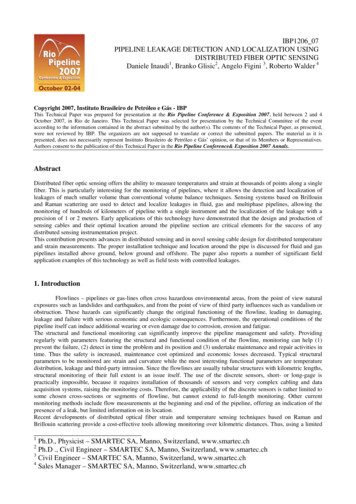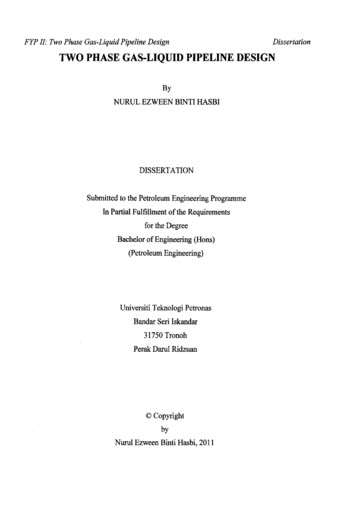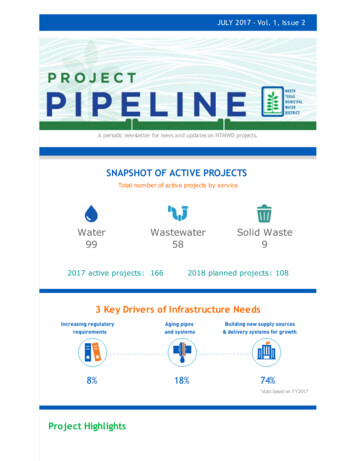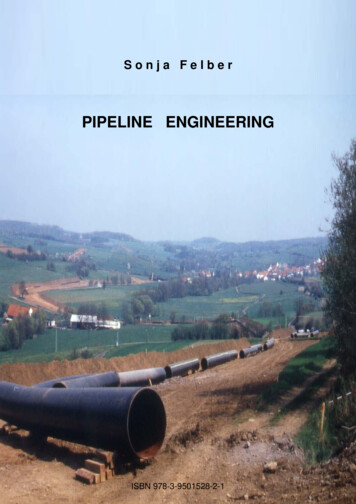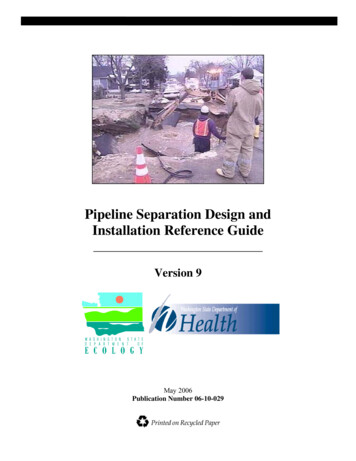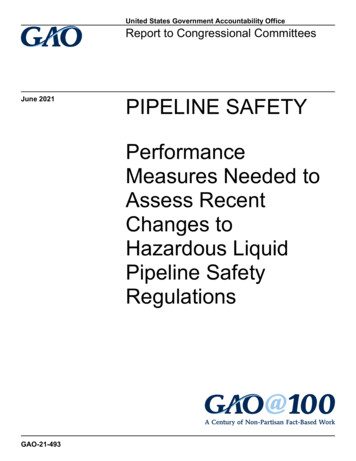
Transcription
United States Government Accountability OfficeReport to Congressional CommitteesJune 2021PIPELINE SAFETYPerformanceMeasures Needed toAssess RecentChanges toHazardous LiquidPipeline SafetyRegulationsGAO-21-493
June 2021PIPELINE SAFETYHighlights of GAO-21-493, a report tocongressional committeesPerformance Measures Needed to Assess RecentChanges to Hazardous Liquid Pipeline SafetyRegulationsWhy GAO Did This StudyWhat GAO FoundThe U.S. hazardous liquid pipelinenetwork runs for over 220,000 milesand is a critical component of thenation’s economy. Pipelines areconsidered to be a relatively safe modeof transporting crude oil, refinedpetroleum products, and otherhazardous liquids, but accidents canoccur that result in loss of life andenvironmental damage. PHMSA, withinthe Department of Transportation(DOT), sets the federal minimumpipeline safety standards and generallyensures operator compliance.In 2019, the Pipeline and Hazardous Materials Safety Administration (PHMSA)issued a final rule amending its hazardous liquid pipeline safety regulations.Selected pipeline operators and officials from PHMSA and selected states’pipeline safety offices said that these changes would enhance pipeline safetyand present no significant challenges. They said the most beneficial changesexpanded the scope of inspections. For example, in addition to existingrequirements for operators to use specialized tools to inspect pipelines in “highconsequence areas”—defined by population and environmental factors—the2019 Rule requires such inspections outside of those areas. While operatorsnoted the rule’s potential to improve safety, all 11 operators GAO interviewedidentified specific amendments that could increase their costs. For example,several operators said they would need to modify or replace some of theirpipeline to allow for certain inspection tools required by the changes. PHMSAand state pipeline safety officials said they did not anticipate oversight challengesor additional costs because the changes did not alter their inspection process.In 2016, a pipeline safety statuteincluded a provision for GAO to reporton hazardous liquid pipeline safetyafter PHMSA issued a specific finalrule amending its safety regulations,which it did in 2019. This reportexamines: (1) perspectives of selectedpipeline stakeholders on the benefitsand challenges of the amendmentsmade by the 2019 Rule and (2) stepsPHMSA has taken to informstakeholders of these amendmentsand to measure their effects onpipeline safety. GAO reviewed relevantstatutes and regulations; analyzedPHMSA accident data from calendaryears 2011-2020; interviewed 11pipeline operators—selected bypipeline type, miles, and producttype—as well as pipeline industry andsafety stakeholders, and PHMSA andpipeline safety officials from six states.What GAO RecommendsPHMSA should develop and useperformance measures to assesswhether the changes made by the2019 Rule achieve desired outcomesand improve safety. DOT concurredwith GAO’s recommendation.View GAO-21-493. For more information,contact Elizabeth Repko at (202) 512-2834 orrepkoe@gao.gov.Specialized In-Line Inspection Tool Being Placed in a Launch Point on a PipelinePHMSA held meetings with and provided guidance to operators and inspectorson the changes but has not developed measures to assess if the changesimprove safety. Leading performance management practices call for agencies totrack progress toward goals using measures that include targets for expectedlevels of performance and timeframes. While PHMSA has desired outcomes forthe 2019 Rule, including safety improvements, PHMSA officials said they havenot established performance measures for those outcomes because some of thechanges have long-term compliance deadlines, and so data are not yet availableto assess effectiveness. However, other changes have shorter-term deadlines forcompliance and PHMSA could use data it already collects from operators for itsassessment. Without performance measures, PHMSA cannot determine whetherthe changes made by the 2019 Rule are achieving their intended outcomes andcontributing to PHMSA’s safety goals.United States Government Accountability Office
ContentsLetter1BackgroundSelected Stakeholders Identified Likely Safety Benefits and FewOperational Challenges from PHMSA’s Changes to ItsHazardous Liquid Pipeline RegulationsPHMSA Has Taken Steps to Communicate the Changes Made bythe 2019 Rule to Stakeholders but Has Not DevelopedMeasures to Assess the Changes’ Effect on SafetyConclusionsRecommendation for Executive ActionAgency Comments522272727Appendix IObjectives, Scope, and Methodology29Appendix IISummary of Key Amendments by the Pipeline and HazardousMaterials Safety Administration’s (PHMSA) October 1, 2019, FinalRule to 49 C.F.R. Part 19535Appendix IIIComments from the Department of Transportation37Appendix IVGAO Contact and Staff Acknowledgements3815TablesTable 1: Summary of the Pipeline and Hazardous Materials SafetyAdministration’s (PHMSA) October 1, 2019, Final RuleAmending the Hazardous Liquid Pipeline SafetyRegulationsTable 2: Hazardous Liquid Pipeline Associations andOrganizations Selected for InterviewsTable 3: Hazardous Liquid Pipeline Operators Selected forInterviewsTable 4: Pipeline and Hazardous Materials Safety Administration’sRegional Officials and State Agency (PHMSA) OfficialsSelected for InterviewsPage i14313233GAO-21-493 Hazardous Liquid Pipeline Safety
Table 5: Summary of Key Amendments by the Pipeline andHazardous Materials Safety Administration’s (PHMSA)October 1, 2019, Final Rule to 49 C.F.R. Part 19535FiguresFigure 1: Hazardous Liquid Pipeline NetworkFigure 2: In-Line Inspection Tool Being Placed in a Launch Pointon a PipelineFigure 3: Total Hazardous Liquid Pipeline Accidents andAccidents Impacting People or the Environment,Reported by Operators from Calendar Years 2011through 2020Figure 4: Primary Causes of Hazardous Liquid Pipeline AccidentsImpacting People or the Environment, Reported byOperators in Calendar Years 2011 through 2020Figure 5: Views of Selected Pipeline Operators, of Pipeline andHazardous Materials Safety Administration Officials, andof State Officials on which of the Changes Made by the2019 Rule Will Likely Provide the Greatest SafetyBenefitsPage ii710111316GAO-21-493 Hazardous Liquid Pipeline Safety
AbbreviationsAPIDOTHCANTSBOPIDPHMSAAmerican Petroleum InstituteDepartment of Transportationhigh consequence areaNational Transportation Safety BoardOperator Identification NumberPipeline and Hazardous Materials Safety AdministrationThis is a work of the U.S. government and is not subject to copyright protection in theUnited States. The published product may be reproduced and distributed in its entiretywithout further permission from GAO. However, because this work may containcopyrighted images or other material, permission from the copyright holder may benecessary if you wish to reproduce this material separately.Page iiiGAO-21-493 Hazardous Liquid Pipeline Safety
Letter441 G St. N.W.Washington, DC 20548June 22, 2021The Honorable Maria CantwellChairmanThe Honorable Roger WickerRanking MemberCommittee on Commerce, Science and TransportationUnited States SenateThe Honorable Frank PalloneChairmanThe Honorable Cathy McMorris RodgersRanking MemberCommittee on Energy and CommerceHouse of RepresentativesThe Honorable Peter A. DeFazioChairmanThe Honorable Sam GravesRanking MemberCommittee on Transportation and InfrastructureHouse of RepresentativesThe U.S. oil industry is a critical component of the nation’s economy,providing energy for transportation, manufacturing, and residential use,while creating jobs and reducing imports. The nation’s network of nearly225,000 miles of hazardous liquid pipelines is primarily regulated by theDepartment of Transportation’s (DOT) Pipeline and Hazardous MaterialsSafety Administration (PHMSA). According to PHMSA, pipelines are oneof the safest and least costly ways to deliver hundreds of billions ofgallons of crude oil, refined petroleum products, and other hazardousliquids each year. 1 However, accidents do occur that cause significantdamage to life, property, and the environment. Risk factors for suchaccidents include pipeline corrosion and age, as well as severe weatherevents. For example, in July 2010, a pipeline in Marshall, Michigan,ruptured due to corrosion, causing about 840,000 gallons of crude oil to1Ourreport discusses pipelines that carry hazardous liquids including crude oil, refinedpetroleum products, highly volatile liquids (hazardous liquids that form a vapor cloud whenreleased into the atmosphere), and non-petroleum fuel (e.g., biofuel). Our discussion alsoincludes pipelines that carry liquefied carbon dioxide.Page 1GAO-21-493 Hazardous Liquid Pipeline Safety
enter the surrounding wetlands and nearby rivers, resulting in cleanupcosts exceeding 767 million and in hundreds of people experiencingsymptoms related to crude oil exposure, according to the NationalTransportation Safety Board’s (NTSB) 2012 accident report. 2PHMSA, states, and pipeline operators each have a role in ensuringpipeline safety. PHMSA sets and enforces the federal minimum pipelinesafety standards for interstate hazardous liquid pipelines, which transportthese liquids across state borders. 3 To ensure operators’ compliance withpipeline safety regulations, PHMSA conducts inspections of interstatepipelines. PHMSA also sets the minimum safety standards for intrastatehazardous liquid pipelines, which operate within a single state. However,states may assume regulatory, inspection, and enforcement authority forintrastate pipelines after certifying to PHMSA that they have adopted andare enforcing applicable federal standards. 4 PHMSA may also enter intoagreements with states that permit them to participate in the oversightand inspection of interstate pipelines, but PHMSA retains enforcementauthority. PHMSA takes a risk-based approach to pipeline safety andrequires operators to have integrity management programs to identify andmitigate risks to pipelines located in areas where an accident would havegreater consequences for public safety or the environment.In October 2019, PHMSA issued a final rule amending its hazardousliquid safety regulations to improve the protection of the public, property,and environment. 5 PHMSA made these changes in response tocongressional mandates, lessons learned from pipeline accidents, and2NTSB,Enbridge Incorporated, Hazardous Liquid Pipeline Rupture and Release,Marshall, Michigan, July 25, 2010, Accident Report, NTSB/PAR-12/01 (Washington, D.C.:July 10, 2012).3PHMSA’sgeneral authority is under the Pipeline Safety Laws codified at 49 U.S.C.§ 60101 et seq.4Statesmust submit these certifications to PHMSA annually. States with currentcertifications may adopt additional or more stringent safety standards as long as they arecompatible with federal standards.5PipelineSafety: Safety of Hazardous Liquid Pipelines, 84 Fed. Reg. 52,260 (Oct. 1,2019) (amending 49 C.F.R. pt. 195). We will refer to this as the 2019 Rule.Page 2GAO-21-493 Hazardous Liquid Pipeline Safety
recommendations by NTSB and GAO. 6 The Protecting our Infrastructureof Pipelines and Enhancing Safety Act of 2016 (PIPES Act of 2016)includes a provision for GAO to report on integrity management programsfor hazardous liquid pipeline facilities after the publication of PHMSA’sfinal rule on hazardous liquid pipeline safety. 7 This report examines: perspectives of selected hazardous liquid pipeline stakeholders on thebenefits and challenges of the amendments made by the 2019 Rule,and steps PHMSA has taken to inform stakeholders of the amendmentsand to measure their effect on the safety of hazardous liquid pipelines.To address these objectives, we reviewed relevant statutes, regulations,and PHMSA’s policies, procedures, and guidance for operators onpipeline safety practices and the roles and responsibilities of officials atthe PHMSA’s regional offices and state agencies. We also reviewedpublications and studies from NTSB, industry, and non-industry groups ontopics related to the safety of hazardous liquid pipelines. We used themost recent data from PHMSA’s operator annual report (2019) todescribe the characteristics of the U.S. hazardous liquid pipeline system,including pipeline miles, type of pipeline, and the number of pipelineoperators that reported to PHMSA.We also analyzed PHMSA’s data over a 10-year period (from 2011 to2020) on hazardous liquid pipeline accidents, including the number ofaccidents, barrels of product released, location, cause, and the number ofaccidents that met PHMSA’s definition of an accident impacting people orthe environment—a category of accident established by PHMSA anddescribed in greater detail below. We assessed the reliability of PHMSAdata by speaking with agency officials about data control procedures and6See Pipeline Safety, Regulatory Certainty, and Job Creation Act of 2011 (2011 PipelineSafety Act), Pub. L. No. 112–90, 125 Stat. 1904 (2012); Protecting our Infrastructure ofPipelines and Enhancing Safety Act of 2016 (PIPES Act of 2016), Pub. L. No. 114-183,130 Stat. 514 (2016). Following the Marshall, Michigan pipeline rupture, NTSB made tworecommendations for PHMSA to revise its safety regulations related to: (1) operators’assessment of crack defects and (2) notifying PHMSA of an expected date for informationwhen a determination of pipeline threats is not obtained within 180 days of an inspection.In 2012, GAO recommended that PHMSA collect data from operators of federallyunregulated hazardous liquid and gas gathering pipelines. GAO, Pipeline Safety:Collecting Data and Sharing Information on Federally Unregulated Gathering PipelinesCould Help Enhance Safety, GAO-12-388 (Washington, D.C.: Mar. 22, 2012).7PIPESPage 3Act of 2016 § 5.GAO-21-493 Hazardous Liquid Pipeline Safety
reviewing agency documentation. We determined that these data weresufficiently reliable to describe characteristics of the pipeline network andaccidents that occur along that network. In addition, we reviewed six keyamendments PHMSA made by the 2019 Rule and reviewed PHMSA’sRegulatory Impact Analysis of the final rule, which describes the costsand benefits of these changes. 8 Appendix II describes the six keyamendments in more detail.To obtain stakeholder views of the changes made by the 2019 Rule, weprovided selected hazardous liquid pipeline stakeholders with a summaryof the six key changes, discussed in greater detail below, and interviewedthem on the benefits and challenges of these changes, including relatedcosts, feasibility, and effect on pipeline safety. These stakeholdersincluded representatives from 11 hazardous liquid pipeline operators,three industry associations, four safety and environmental groups, oneassociation that represents state pipeline safety personnel, six statepipeline safety offices, and PHMSA’s five regional offices. 9 We selectedoperators that manage a range of regulated pipeline systems, includingthose of different types (e.g., transmission and gathering, as discussedbelow); size (number of pipeline miles managed); and commoditiestransported (e.g., crude oil, refined petroleum products, and highly volatileliquids). The views presented in our report provide perspectives of arange of knowledgeable stakeholders on the changes, but are notgeneralizable to all stakeholders.To assess the steps that PHMSA has taken to inform stakeholders of thechanges made by the 2019 Rule and measure their effect on pipelinesafety, we reviewed documentation, such as presentation materialsprovided at PHMSA-led meetings, PHMSA’s responses to frequentlyasked questions to clarify the changes, and guidance on ruleimplementation. We also interviewed officials at PHMSA’s headquartersoffice. We obtained stakeholder perspectives on PHMSA’s outreach8Pipelineand Hazardous Materials Safety Administration, Doc. No. PHMSA-2010-02290137, Regulatory Impact Analysis: Safety of Hazardous Liquid Pipelines (2019).9Weselected the national pipeline associations and the pipeline safety and environmentalgroups based on their written comments submitted to PHMSA on the amendments to thehazardous liquid pipeline safety regulations that it proposed in 2015 and that werefinalized in the 2019 Rule. Pipeline Safety: Safety of Hazardous Liquid Pipelines, 80 Fed.Reg. 61,610 (proposed Oct. 13, 2015). We selected six of the 15 states’ pipeline safetyoffices that have assumed authority over intrastate hazardous liquid pipelines, three ofwhich also hold an interstate agreement with PHMSA to participate in the oversight ofinterstate hazardous liquid pipelines.Page 4GAO-21-493 Hazardous Liquid Pipeline Safety
efforts by interviewing the selected operators, PHMSA regional offices,and states’ pipeline safety offices noted above. We also reviewedPHMSA’s intended safety outcomes of the 2019 Rule, as well as thedepartment-wide performance goals in DOT’s FY 2021 PerformancePlan. 10 We compared PHMSA’s efforts to measure the effects of the 2019Rule on the identified outcomes and performance goals against leadingpractices for strategic planning identified by our prior work and therequirements under the GPRA Modernization Act of 2010, as amended. 11For a more detailed description of our methodology, see appendix I.We conducted this performance audit from April 2020 to June 2021 inaccordance with generally accepted government auditing standards.Those standards require that we plan and perform the audit to obtainsufficient, appropriate evidence to provide a reasonable basis for ourfindings and conclusions based on our audit objectives. We believe thatthe evidence obtained provides a reasonable basis for our findings andconclusions based on our audit objectives.BackgroundComponents of theNational Network ofHazardous LiquidPipelinesThe U.S. economy relies on a network of hazardous liquid pipelines thattransport a wide range of oil products supporting various sectors of theeconomy, including energy, transportation, and manufacturing. Theseproducts include crude oil, refined petroleum products—such as jet fuel,gasoline, and home heating oil—and liquefied gas products, such ascarbon dioxide. 12 According to PHMSA, in 2019, about 157,000 of thesemiles were interstate hazardous liquid pipelines—pipelines that transportthese liquids across states—and about 68,000 miles were intrastatehazardous liquid pipelines—pipelines transporting these liquids within astate.10DOT,FY 2021 Performance Plan and FY 2019 Performance Report (Mar. 23, 2020).11GAO,Agency Performance Plans: Examples of Practices That Can Improve Usefulnessto Decisionmakers, GAO/GGD/AIMD-99-69, (Washington, D.C.: Feb. 26, 1999). GPRAModernization Act of 2010, Pub. L. No. 111-352, 124 Stat. 3866 (2011).12According to operator reports to PHMSA, in calendar year 2019, about 37 percent of thenation’s hazardous liquid pipeline miles predominantly transported crude oil, 32 percent ofthe pipeline miles predominantly transported highly volatile liquids (e.g., propane, butane,and ammonia), 28 percent of the pipeline miles predominantly transported refinedpetroleum products like gasoline, and 2 percent of pipeline miles transported carbondioxide and fuel grade ethanol.Page 5GAO-21-493 Hazardous Liquid Pipeline Safety
Within this nationwide network, there are two main types of hazardousliquid pipelines—gathering pipelines and transmission pipelines: Gathering pipelines transport hazardous liquids from oil well heads tostorage and treatment facilities, before these liquids are sent torefineries for processing. Gathering pipelines are typically less than 9inches in diameter and are generally located in rural areas. Transmission pipelines carry hazardous liquids from gathering lines torefining, processing, or storage facilities, and carry refined petroleumproducts, such as gasoline and fuel oils, to customers for use orfurther transportation. These pipelines are typically from 12 inches to42 inches in diameter and have greater operating pressure thangathering pipelines. According to operator reports submitted toPHMSA, these pipelines made up about 98 percent (about 225,000pipeline miles) of the pipeline network in 2019. 13Hazardous liquid pipeline networks also include pump stations, whichmove the product through the pipelines, and storage terminals. (See fig.1.)13Gravitypipelines are also a part of the hazardous liquid pipeline network. Thesepipelines carry product by means of gravity, and many are short and are located withintank farms or other pipeline facilities. Prior to the 2019 Rule, gravity pipelines were notregulated by PHMSA. The 2019 Rule extends reporting requirements to certain,previously unregulated gravity pipelines. Operators of these pipelines must now submitannual reports to PHMSA that include information such as the miles of gravity pipeline aswell as accident and safety-related condition reports. In 2019, PHMSA stated that therewas an estimated 28 miles of gravity pipelines, managed by a total of five operators thatwould be subject to these extended reporting requirements.Page 6GAO-21-493 Hazardous Liquid Pipeline Safety
Figure 1: Hazardous Liquid Pipeline NetworkThese pipeline networks are owned and managed by hazardous liquidpipeline operators, which vary in the amount of pipeline they own,corporate structure, and management organization. An estimated 500hazardous liquid pipeline operators manage networks ranging from fewerthan 50 miles to more than 2,000 miles of pipeline. The corporatestructures of operators also vary. For example, some operators may beindependent and others may be subsidiaries of larger companies.Additionally, some operators form partnerships where networks are jointlyowned, with one of the operators managing the network for all partners.Federal and StateOversightPHMSA sets the federal minimum safety standards for pipelines, such asspecifications for their design, construction, testing, inspection, operation,and maintenance. 14 PHMSA also oversees the risk-based regulatory14PHMSA does not regulate all pipelines. For example, there are several types ofhazardous liquid low-stress pipelines—pipelines that are operated in their entirety at astress level of 20 percent or less of the specified minimum yield strength of the line pipe—that are not regulated by PHMSA as well as pipelines moving hazardous liquid throughproduction, refining, or manufacturing facilities. 49 C.F.R. § 195.1(b).Page 7GAO-21-493 Hazardous Liquid Pipeline Safety
program referred to as integrity management. Under PHMSA’s integritymanagement program, operators are required to systematically identifyand mitigate risks to a pipeline located in or that could affect a highconsequence area (HCA), where an accident would have greaterconsequences for public safety or the environment. 15 PHMSA requiresoperators to determine likely threats to the pipelines within HCAs,evaluate the physical integrity of the pipe within the HCA, and repair orremediate any pipeline defects found. 16 According to PHMSA, about 42percent of the nation’s regulated hazardous liquid pipelines in 2019 werelocated in such an area.To ensure operators comply with federal minimum safety standards andintegrity management program requirements, PHMSA conductsinspections through its five regional offices and enters into agreementswith certain states for them to conduct inspections. Under federal pipelinesafety laws, states may assume regulatory, inspection, and enforcementresponsibilities for intrastate pipelines through certification with PHMSA. 17PHMSA may also enter into agreements with states that havecertifications to participate in the inspections of interstate pipelines asinterstate “agents” of PHMSA. 18 While state inspectors can identify andmust report violations or probable violations of the federal pipeline safetyregulations on interstate pipelines to PHMSA, PHMSA retainsenforcement authority over these pipelines. As of 2021, 15 states haveassumed jurisdiction over intrastate pipelines through certification, andfive of those states also act as interstate agents. 19 The frequency ofinterstate pipeline inspections depends on PHMSA’s determination of riskand priorities. Inspections may include on-site inspection of operatordocumentation, field inspection of pipelines, and briefings on findings withoperators.15Underthe hazardous liquid pipeline regulations, HCAs generally include high populationareas, other populated areas, certain navigable waterways, and areas unusually sensitiveto environmental damage. 49 C.F.R. § 195.450.16Id.§ 195.452.1749U.S.C. § 60105.18Id.§ 60106.19Forcalendar year 2021, the following states had the authority to inspect intrastatepipelines: Alabama, Arizona, California, Indiana, Louisiana, Maryland, Minnesota, NewYork, New Mexico, Oklahoma, Pennsylvania, Texas, Virginia, Washington, and WestVirginia; and the following states had the authority to inspect both intrastate and interstatepipelines: Arizona, Minnesota, New York, Virginia, and Washington.Page 8GAO-21-493 Hazardous Liquid Pipeline Safety
Safety ImprovementsIn recent decades, according to PHMSA, pipeline manufacturing andconstruction as well as operations and maintenance practices haveimproved steadily, helping to mitigate risks, such as corrosion andpipeline cracking, to pipeline safety. For example, according to PHMSA,since the early 1970s, improvements in pipeline materials andmanufacturing, such as advances in the welding of seams that bindpipeline segments together, have made pipelines less susceptible todefects. Additionally, pipeline operators now can use technologies—forexample, leak detection systems and tools for in-line inspection—thathelp determine the condition of pipelines and identify anomalies, such ascorrosion, cracks, and dents. Leak detection systems use sensors andgauges placed along pipeline that can monitor the product passingthrough the pipelines and detect drops in pressure that might indicate aleak. 20 In-line inspections are conducted by inserting specialized tools intoa pipeline through launch and retrieval points in the system to detect andrecord anomalies, such as metal loss and damage from corrosion (seefig. 2). In addition, the American Petroleum Institute (API) developsstandards and recommended practices for industry to use to enhancevarious aspects of pipeline safety. 2120Operatorsmay also use computational monitoring systems that track changes intemperature, terrain, or distance from a pump station. These factors are all variablesaffecting product volume that can indicate a leak.21API standards development is approved by the American National Standards Institute,which is a private, nonprofit organization whose mission is to promote and facilitatevoluntary consensus standards and promote their integrity. API’s membership is open tocorporations involved in the oil and natural gas industry or that support the industry.Page 9GAO-21-493 Hazardous Liquid Pipeline Safety
Figure 2: In-Line Inspection Tool Being Placed in a Launch Point on a PipelineData on Pipeline AccidentsPHMSA data show that while the number of pipeline accidents hasdeclined in recent years, some accidents can have significantconsequences. PHMSA requires operators to report information onpipeline accidents resulting in a release of hazardous liquids. 22Hazardous liquid pipeline accidents increased from 344 accidents incalendar year 2011 to 460 accidents in 2015, which had the mostaccidents over the 10-year period we reviewed. Operators reported 330hazardous liquid pipeline accidents in calendar year 2020, a reduction ofabout 28 percent from 2015. In addition, accidents resulting in fatalities,injuries, or an impact on the environment have also declined. Specifically,accidents that PHMSA identifies as those impacting people or theenvironment—a performance measure that PHMSA developed withsafety and industry groups—have declined about 43 percent since 201522For example, PHMSA requires operators to submit information on accidents that release5 gallons or more of product, including information on the amount, location, timing,impacts on people and the environment, and cause of the release. 49 C.F.R. § 195.50(b).Page 10GAO-21-493 Hazardous Liquid Pipeline Safety
(see fig. 3). 23 According to PHMSA, while such accidents are relativelyrare, they can have significant consequences. For example, according toPHMSA data, hazardous liquid pipeline accidents over the last 10 yearshave resulted in 8 fatalities and 14 injuries, and some accidents resultedin the release of hundreds of thousands of gallons of crude oil in HCAs.Figure 3: Total Hazardous Liquid Pipeline Accidents and Accidents ImpactingPeople or the Environment, Reported by Operators from Calendar Years 2011through 202023PHMSA defines an accident as impacting people or the environment if it meets one ofthe following two criteria: (1) Regardless of the accident’s location, any of the followingoccur: a fatality, injury requiring in-patient hospitalization, ignition, explosion, evacuation,wildlife impact, contamination of specific water sources, or damage to public or private,non-operator property. (2) Where the accident’s location is not totally contained onoperator-controlled property, any of the following occur: an unintentional release of equalto or greater than 5 gallons that is in an HCA, an unintentional release of equal to orgreater than 5 barrels that is outside an HCA, surface water contamination, or soilcontamination.Page 11GAO-21-493 Hazardous Liquid Pipeline Safety
The majority of accidents in the last 10 years occurred on pipelineoperators’ property and were leaks rather than ruptures. PHMSA’s datashowed the majority of accidents in the last 10 years were contained onoperator properties, such as pump stations and tank farms, and resultedin less than 5 barrels (approximately 210 gallons) of product released peraccident. 24 For example, across the 10 years we examined (2011-2020)
pipeline to allow for certain inspection tools required by the changes. PHMSA and state pipeline safety officials said they did not anticipate oversight challenges . Pipeline Safety: Safety of Hazardous Liquid Pipelines, 84 Fed. Reg.52,260 (Oct. 1, 2019) (amending 49 C.F.R. pt. 195). We will refer to this as the 2019 Rule.
